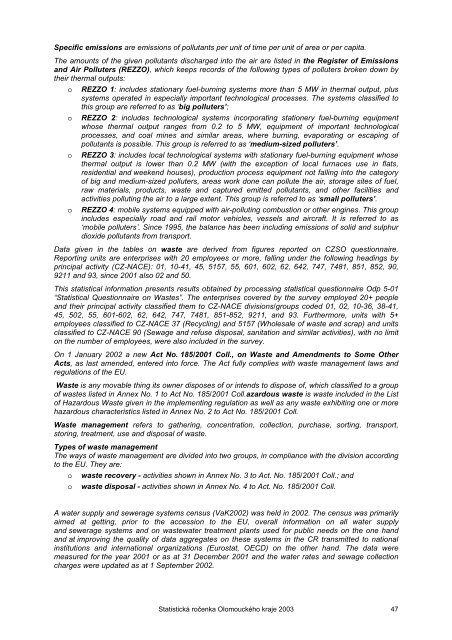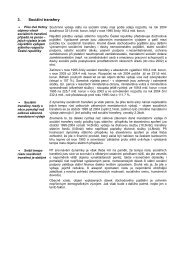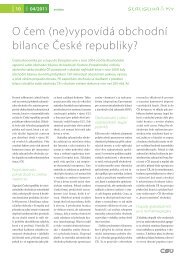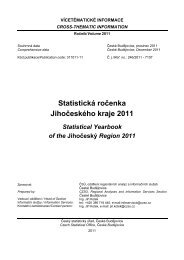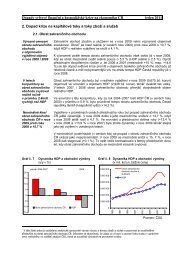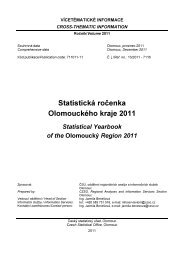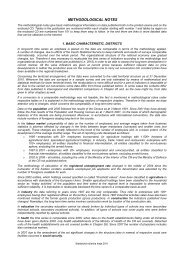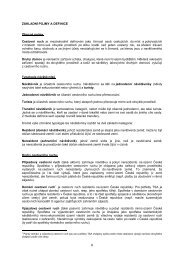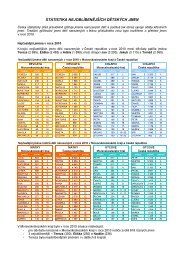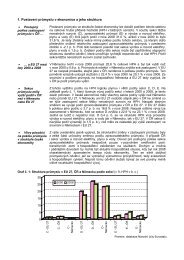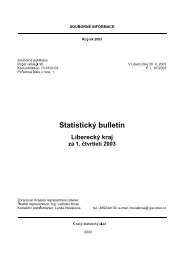Statistická ročenka Olomouckého kraje 2003 - Český statistický úřad
Statistická ročenka Olomouckého kraje 2003 - Český statistický úřad
Statistická ročenka Olomouckého kraje 2003 - Český statistický úřad
Create successful ePaper yourself
Turn your PDF publications into a flip-book with our unique Google optimized e-Paper software.
Specific emissions are emissions of pollutants per unit of time per unit of area or per capita.The amounts of the given pollutants discharged into the air are listed in the Register of Emissionsand Air Polluters (REZZO), which keeps records of the following types of polluters broken down bytheir thermal outputs:o REZZO 1: includes stationary fuel-burning systems more than 5 MW in thermal output, plussystems operated in especially important technological processes. The systems classified tothis group are referred to as ‘big polluters’;o REZZO 2: includes technological systems incorporating stationery fuel-burning equipmentwhose thermal output ranges from 0.2 to 5 MW, equipment of important technologicalprocesses, and coal mines and similar areas, where burning, evaporating or escaping ofpollutants is possible. This group is referred to as ‘medium-sized polluters’.o REZZO 3: includes local technological systems with stationary fuel-burning equipment whosethermal output is lower than 0.2 MW (with the exception of local furnaces use in flats,residential and weekend houses), production process equipment not falling into the categoryof big and medium-sized polluters, areas work done can pollute the air, storage sites of fuel,raw materials, products, waste and captured emitted pollutants, and other facilities andactivities polluting the air to a large extent. This group is referred to as ‘small polluters’.o REZZO 4: mobile systems equipped with air-polluting combustion or other engines. This groupincludes especially road and rail motor vehicles, vessels and aircraft. It is referred to as‘mobile polluters’. Since 1995, the balance has been including emissions of solid and sulphurdioxide pollutants from transport.Data given in the tables on waste are derived from figures reported on CZSO questionnaire.Reporting units are enterprises with 20 employees or more, falling under the following headings byprincipal activity (CZ-NACE): 01, 10-41, 45, 5157, 55, 601, 602, 62, 642, 747, 7481, 851, 852, 90,9211 and 93, since 2001 also 02 and 50.This statistical information presents results obtained by processing statistical questionnaire Odp 5-01“Statistical Questionnaire on Wastes”. The enterprises covered by the survey employed 20+ peopleand their principal activity classified them to CZ-NACE divisions/groups coded 01, 02, 10-36, 38-41,45, 502, 55, 601-602, 62, 642, 747, 7481, 851-852, 9211, and 93. Furthermore, units with 5+employees classified to CZ-NACE 37 (Recycling) and 5157 (Wholesale of waste and scrap) and unitsclassified to CZ-NACE 90 (Sewage and refuse disposal, sanitation and similar activities), with no limiton the number of employees, were also included in the survey.On 1 January 2002 a new Act No. 185/2001 Coll., on Waste and Amendments to Some OtherActs, as last amended, entered into force. The Act fully complies with waste management laws andregulations of the EU.Waste is any movable thing its owner disposes of or intends to dispose of, which classified to a groupof wastes listed in Annex No. 1 to Act No. 185/2001 Coll.azardous waste is waste included in the Listof Hazardous Waste given in the implementing regulation as well as any waste exhibiting one or morehazardous characteristics listed in Annex No. 2 to Act No. 185/2001 Coll.Waste management refers to gathering, concentration, collection, purchase, sorting, transport,storing, treatment, use and disposal of waste.Types of waste managementThe ways of waste management are divided into two groups, in compliance with the division accordingto the EU. They are:o waste recovery - activities shown in Annex No. 3 to Act. No. 185/2001 Coll.; ando waste disposal - activities shown in Annex No. 4 to Act. No. 185/2001 Coll.A water supply and sewerage systems census (VaK2002) was held in 2002. The census was primarilyaimed at getting, prior to the accession to the EU, overall information on all water supplyand sewerage systems and on wastewater treatment plants used for public needs on the one handand at improving the quality of data aggregates on these systems in the CR transmitted to nationalinstitutions and international organizations (Eurostat, OECD) on the other hand. The data weremeasured for the year 2001 or as at 31 December 2001 and the water rates and sewage collectioncharges were updated as at 1 September 2002.<strong>Statistická</strong> <strong>ročenka</strong> <strong>Olomouckého</strong> <strong>kraje</strong> <strong>2003</strong> 47


